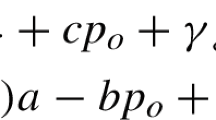Abstract
In this paper, we study a two-echelon supply chain inventory system with a single manufacturer and a single buyer, considering price-dependent demand and variable lead time. Lead time can be reduced by added crashing cost. We first assume that the lead time demand follows a normal probability distribution and then consider the case where it is distribution free. We develop both the centralized and decentralized models and derive the optimal solutions by using profit maximization criterion. Feasibility and efficiency of the proposed models are justified through two numerical examples. We numerically investigate how the optimal decisions are affected by changes in various model-parameters. From numerical study, we observe that even though the lead time reduction diminishes the retailer’s selling price, it enhances the system profit significantly.
Similar content being viewed by others
References
Liao C, Shyu C (1991) An analytical determination of lead time with normal demand. Int J Oper Prod Manage 11:72– 78
Gallego G, Moon I (1993) The distribution free newsboy problem: Review and extensions. J Oper Res Soc 44:825–834
Ben-Daya M, Raouf A (1994) Inventory models involving lead time as a decision variable. J Oper Res Soc 45:579– 582
Ouyang L, Yen N, Wu K (1996) Mixture inventory model with back orders and lost sales for variable lead time. J Oper Res Soc 47:829–832
Ouyang LY, Wu KS (1997) Mixture inventory model involving variable lead time with a service level constraint. Comput Oper Res 24:875–882
Moon I, Choi S (1998) A note on lead time and distributional assumptions in continuous review inventory models. Comput Oper Res 25:1007–1012
Hariga M, Ben-Daya M (1999) Some stochastic inventory models with deterministic variable lead time. Eur J Oper Res 113:42– 51
Ouyang LY, Chen CK, Chang HC (1999) Lead time and ordering cost reductions in continuous review inventory systems with partial back orders. J Oper Res Soc 50:1272–1279
Pan J, Hsiao Y, Lee C (2002) Inventory model with fixed and variable lead time crash costs considerations. J Oper Res Soc 53:1048–1053
Pan J, Yang J (2002) A study of integrated inventory with controllable lead time. Int J Prod Res 40:1263–1272
Ouyang L, Wu K, Ho C (2004) Integrated vendor buyer cooperative models with stochastic demand in controllable lead time. Int J Prod Econ 92:255–266
Yang J, Pan J (2004) Just-in-time purchasing: an integrated inventory model involving deterministic variable lead time and quality improvement investment. Int J Prod Res 42:853–863
Chang H, Ouyang L, Wu K, Ho C (2006) Integrated vendor-buyer cooperative inventory models with controllable lead time and ordering cost reduction. Eur J Oper Res 170:481–495
Ouyang L, Wu K, Ho C (2007) An integrated vendor buyer inventory model with quality improvement and lead time reduction. Int J Prod Econ 108:349–358
Chen KK, Chang CT (2007) A seasonal demand inventory model with variable lead time and resource constraints. Appl Math Model 31:2433–2445
Chandra C, Grabis J (2008) Inventory management with variable lead-time dependent procurement cost. Omega 36:877–887
Lin YJ (2009) An integrated vendor buyer inventory model with back order price discount and effective investment to reduce ordering cost. Comput Ind Eng 56:1597–1606
Chang CT, Lo TY (2009) On the inventory model with continuous and discrete lead time, backorders and lost sales. Appl Math Model 33:2196–2206
Jha J, Shanker K (2009) Two-echelon supply chain inventory model with controllable lead time and service level constraint. Comput Ind Eng 57:1096–1104
Annadurai K, Uthayakumar R (2010) Reducing lost-sales rate in (T,R,L) inventory model with controllable lead time. Appl Math Model 34:3465–3477
Ye F, Xu X (2010) Cost allocation model for optimizing supply chain inventory with controllable lead time. Comput Ind Eng 59:93–99
Li Y, Xu X, Ye F (2011) Supply chain coordination model with controllable lead time and service level constraint. Comput Ind Eng 61:858–864
Jha JK, Shanker K (2013) Single-vendor multi-buyer integrated production-inventory model with controllable lead time and service level constraints. Appl Math Model 37:1753–1767
Lau A, Lau H (1998) The newsboy problem with price-dependent demand distribution. IIE Trans 20:168–175
Polatoglu LH (1991) Optimal order quantity and pricing decisions in single-period inventory systems. Int J Prod Econ 23:175–185
Abad PL (1996) Optimal pricing and lot sizing under conditions of perishability and partial back ordering. Manage Sci 42:1093–1104
Wee HM (1997) A replenishment policy for items with a price dependent demand and a varying rate of deterioration. Prod Plan Control 8:494–499
Abad PL (2001) Optimal price and order size for a reseller under partial back ordering. Comput Oper Res 28:53–65
Wee HM, Law ST (2001) Replenishment and pricing policy for deteriorating items taking into account the time-value of money. Int J Prod Econ 71:213–220
Ray S, Jewkes EM (2004) Customer lead time management when both demand and price are lead time sensitive. Eur J Oper Res 153:769–781
Dye CY (2007) Joint pricing and ordering policy for a deteriorating inventory with partial backlogging. Omega 35:184–189
Dye CY, Quyang LY, Hsieh TP (2007) Inventory and pricing strategy for deteriorating items with shortages: a discounted cash flow approach. Comput Ind Eng 52:29–40
Yang CT, Quyang LY, Wu HH (2009) Retailers optimal pricing and ordering policies for non-instantaneous deteriorating items with price-dependent demand and partial backlogging. Math Prob Eng. Article ID 198305; doi:10.1155/2009/198305
Cai G, Chiang WC, Chen X (2011) Game theoretic pricing and ordering decisions with partial lost sales in two stage supply chains. Int J Prod Econ 130:175–185
Chen JM, Cheng Chien MC (2011) On channel coordination through revenue-sharing contracts with price and shelf-space dependent demand. 35:4886–4901
Author information
Authors and Affiliations
Corresponding author
Rights and permissions
About this article
Cite this article
Giri, B.C., Roy, B. Modelling supply chain inventory system with controllable lead time under price-dependent demand. Int J Adv Manuf Technol 84, 1861–1871 (2016). https://doi.org/10.1007/s00170-015-7829-0
Received:
Accepted:
Published:
Issue Date:
DOI: https://doi.org/10.1007/s00170-015-7829-0




